Alpha 700 shoots the Cirque du Soleil
On January 5th, Photoworld was lucky enough to be able to attend the dress rehearsal and official photo-call for the new Cirque du Soleil production at the Royal Albert Hall in London, and to put the Alpha 700 through its paces for high ISO fast action stage show capture. This article with large reproductions of the images appears in our Photoworld issue due out later in January. For once, because the show only runs until February 17th at this venue, we are printed a version here on the Photoclubalpha web pages before the issue goes out. By Google-searching for ‘Varekai Royal Albert Hall’ you can locate many press reviews of the show, with photographs taken at the same time as ours. You can compare the results of the Alpha 700 with three small prime lenses (28, 50, and 100) with mainstream press coverage.
The colour quality of the Alpha, I think, shines against the more typical high-ISO output of the two main brands of pro DSLR, where the methods used for noise reduction have a big impact on saturation.
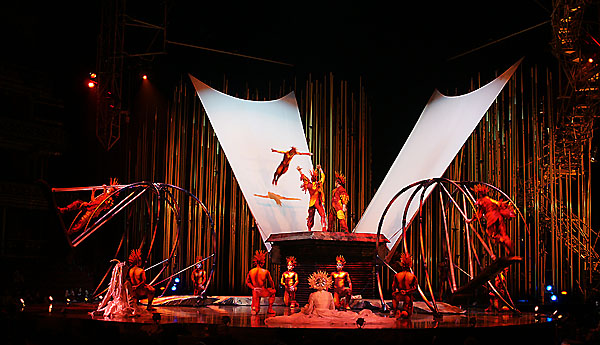
The stage as seen from my seat, using the 28mm f/2 Minolta lens, uncropped horizontally. This was my working distance.
Cirque du Soleil is one of Canada’s best-known exports, and can be found giving performances at multiple locations throughout the world at any time of year. It is not one circus-cabaret company, but any number of troupes drawn from the most talented reserve of international speciality acts.
The performance is a scripted and choreographed blend of stage show, masque, acrobatic ballet and clowning accompanied by genuinely live original music of a unique character (press reviews can be damning, describing it as some sort of ‘world’ music, as if the presence of a fiddle player and an Asturian bagpiper can do that much harm). There is some flexibility to the script to allow different acts to substitute, as many of the acrobatic sequences are physically extreme and demand top athletic condition.
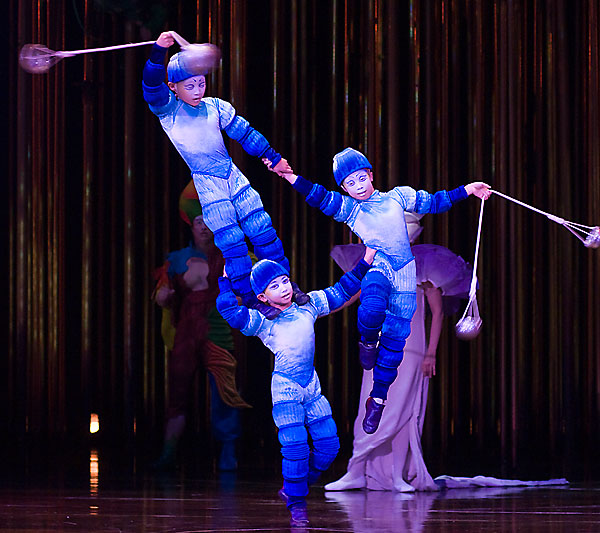
Backing up the performers are catchers and stagehands doubling as part of the act, costumed and choreographed. Their real purpose may be to guarantee the safety of high-flying acts working without harnesses or nets, or to move props around invisibly at speed, but to the audience they appear as costumed figures. All the props and equipment get a similar ‘dressing the part’ treatment so nothing ever looks functional. It will look like a sculpture, a machine, or a giant mobile. Because of this the Cirque du Soleil stage set and performance are uniquely photogenic.
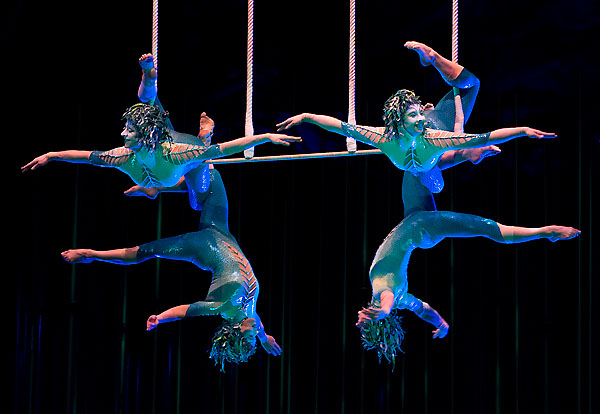
You can compare this Alpha 700 shot with a similar example from the press (TimeOut magazine) on their ents pages.
And photography during a show, of course, is not allowed!
This is not unusual. Nothing would destroy the atmosphere, lighting effects and concentration of the performance more than an audience firing off the usual autoflash compact cameras. It would be positively dangerous.
We first encountered Cirque du Soleil in 2007 in Barcelona, where their show ‘Alegria’ was running under magnificent canvas. Their staff, despite the language barrier, made a brave attempt on a Sunday to secure a photo pass for us! The Cirque team was staying in the same hotel, but we were just passing through, and it couldn’t be arranged. We took in the show and became instant fans. This was something very different.
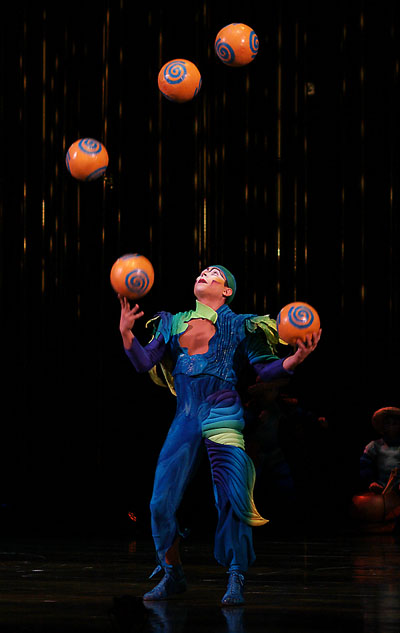
When a press invitation to the dress rehearsal of ‘Varekai’ at the Royal Albert Hall arrived, we decided to do EasyJet from Edinburgh and be there. Just one photo pass could be arranged, as these are strictly rationed, and most of the cameras there were accredited to national newspapers. The photographers’ area of seating was separate, so we sat apart. The Alpha 700 was to get a serious test of its low-light ability shooting the in atmospheric, coloured lighting which varies greatly in brightness.
I took just three lenses – my standard 50mm ƒ1.4, the 28mm ƒ2.8 for full stage shots, and the 100mm ƒ2.8 Soft Focus for most performer shots. This may seem an odd choice, but with the SF function dialled out, this 100mm is faster and more reliable in distant focusing than the 100mm ƒ2.8 macro and every bit as sharp.
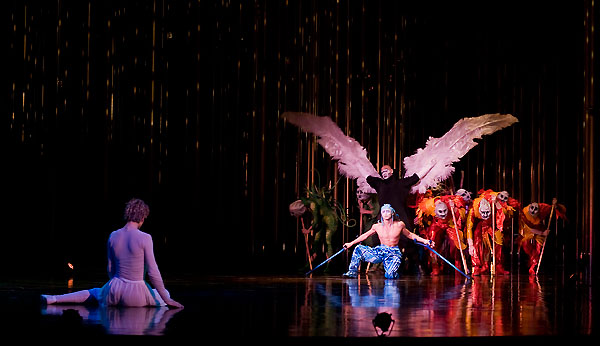
A shot taken with the 50mm f/1.4 at ISO 800, processed from raw. The 50mm tended to back focus badly in this situation, yet outdoor pictures taken of skaters at the Natural History Museum by floodlights shortly beforehand don’t show the same issue. The 28mm and 100mm did not backfocus. I’m investigating this problem!
Working with ISO settings between 400 and 6400, I tested all the main intervals between. Most pictures were taken at ISO 800 or 1600, and perhaps rather too few at 3200. Reviewing the shoot later, the main reason for unusable pictures was marginal subject movement. Serious blur does not matter, it can be creative, but loss of detail without much sense of movement is not welcome. I could have used higher ISOs more, especially the 3200 setting which doesn’t harm detail much.
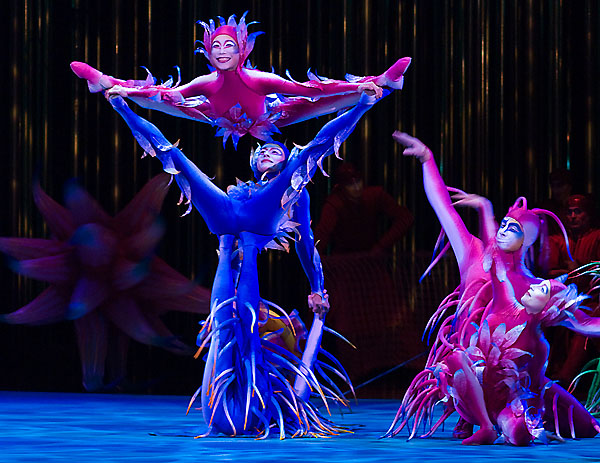
By choosing the peak moment of a display, a shutter speed of 1/20th at f/4 with the 100mm was able to capture this act sharply with SSS to help ensure steady shooting at ISO 800. See further on for an ISO 6400 example, and compare the colour. The Alpha 700 is exceptional for retaining full colour saturation and normal balance even at 6400.
At apertures like ƒ3.5, always stopped down at least half a stop from wide open, shutter speeds were typically around 1/60th but could go as slow as 1/20th and as fast as 1/250th depending on the lighting and my choice of ISO. A surprising number of shots at slow speeds were successful, because it the swinging, balancing, jumping movements of the performers often had definite ‘still points’ where the action reaches a peak and the subject is momentarily hanging in mid-air. I tried to time my shots to catch these moments.
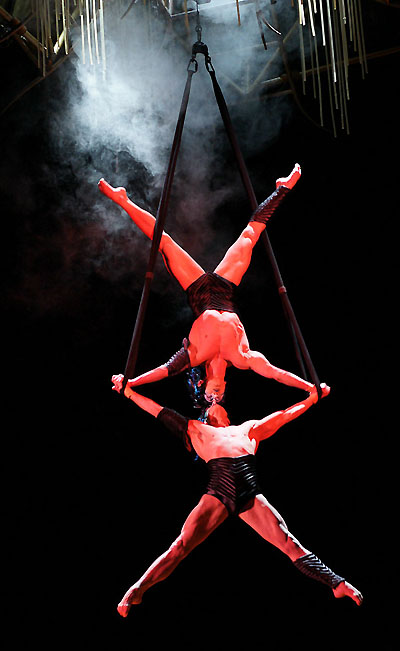
Aerial strap duo, British identical twins Kevin and Andrew Atherton. This unmodified in-camera sRGB JPEG is used full page bleed in the printed magazine. Alpha 700, 100mm SF lens, 1/45th at f/3.5, ISO 1600, tungsten light balance, -0.5 exposure compensation, aperture priority auto, AF centre sensor/hold, matrix metering.
Shooting raw and JPEG, I found that the in-camera processing was very hard to match from raw at high ISOs. The ISO 1600 example above is reproduced full page in the magazine direct from the in-camera JPEG, while most of the others have been processed from raw. I used both tungsten and daylight white balance, depending on the light colour, and found that manual exposure after a quick test was the most reliable. With matrix metering, a setting of between -0.5 and -2 stops compensation gave good results, depending on the type of lighting and subject. Spot metering was totally unpredictable as the performer could move off the spot and the background would then produce a two stop overexposure.
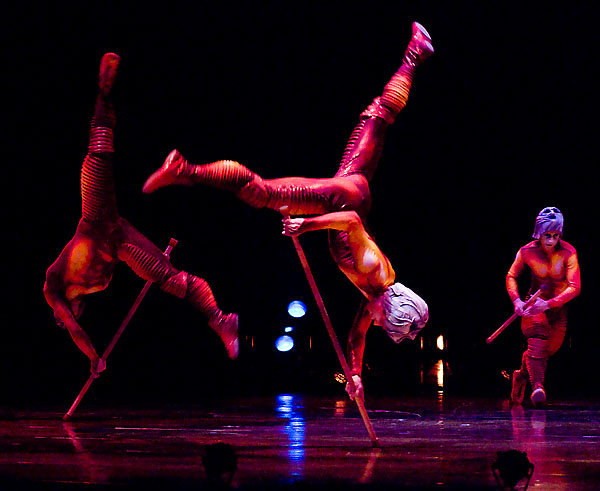
For this 1/250th, f/4, -1 compensation shot ISO 6400 was used and processed from raw in ACR 4.3.1 to give a nice solid background. Photoshop’s Dust and Scratches filter was used to remove bright speckles from the black without affecting the midtones (radius 2, levels 32).
Focus with the 28mm Æ’2 and 100mm Æ’2.8 was perfect, with a few missed frames due to targeting the centre spot but failing to lock. The 50mm Æ’1.4 was a problem and tended to back focus, losing me many sequences. The degree of backfocus was not small either, with the main subject totally blurred and the scene visible through the vertical rods backstage sharp. It’s an old (1985) 50mm and maybe a new Sony one would eliminate this problem. Fortunately, I didn’t use it much as the 100mm was the perfect choice for almost every scene. I would not even have gained much by having the 70-200mm SSM with me.
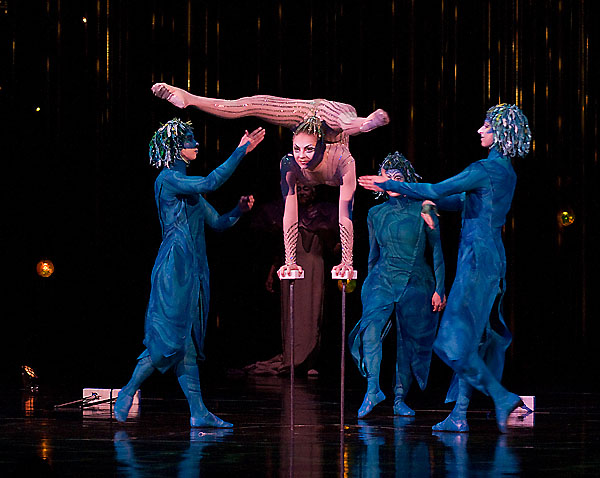
Russian pole balancer Irina Naumenko direct from ISO 800 JPEG.
The press photographers present were mostly equipped with holdalls of gear, tripods, multiple very large Canon and Nikon bodies and cumbersome glassware. My kit was, in contrast, almost invisible. With SSS there was no need for a pod, and the 100mm Æ’2.8 really did everything I needed. When we arrived, no photo pass was waiting for me. Something had gone wrong and the request had not been allocated. Brando, the PR agent for Cirque du Soleil, acted very quickly and arranged a pass with a transfer of seating position. They asked to see my equipment, because I was not apparently carrying any, just a small laptop bag. The bar was full of press guys with gear piled all over. On seeing the Alpha with 100mm, I was told that if the press photo seat could not be arranged I might be allowed to shoot anyway from a normal audience area. They segregate the press because all their gear is troublesome (one shooter was occupying two seats in my row, forcing people to move up by setting up tripods to operate multiple cameras). But I clearly didn’t fall into that category…
Anyway, no such dispensation was needed, as the photo pass was available.
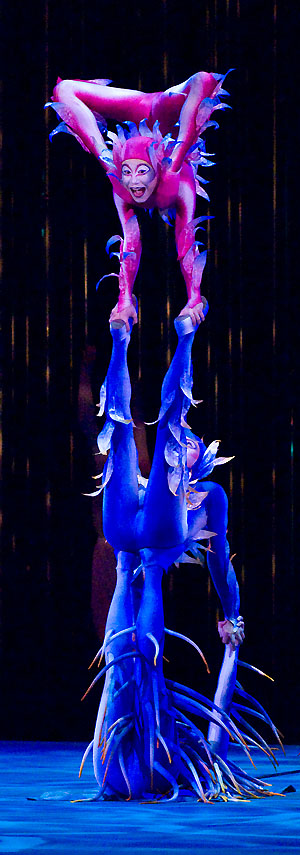
Here is an ISO 6400 example which you can match with the ISO 800 one earlier. The colour doesn’t suffer at all. It is a pity to shoot a spectacle like Cirque du Soleil on any camera which produces less!
The colours of the high ISO Alpha 700 images are exceptional. I know no other DSLR which retains saturation as well at ISO 6400. For this shoot, colour really mattered. From 1600 to 6400 the Alpha 700 applies progressively stronger noise reducion which removes fine texture but leaves critical high contrast detail, such as eyes, intact. The images print exceptionally well even though they have a slightly artificial look when viewed at 100 per cent on screen.

We were told not to shoot any pictures until ‘the creature’ came on stage. Since all the costumes looked like creatures, no-one had any real idea what this meant. I suspect this was the creature. Or was she? It didn’t matter, as all the press were shooting from the moment they entered the auditorium! This picture is used full page in the magazine, and reproduced from an ISO 800 shot processed using ACR 4.3.1 (Adobe Photoshop CS with Bridge, Camera Raw Converter version 4.3.1, Mac OSX).
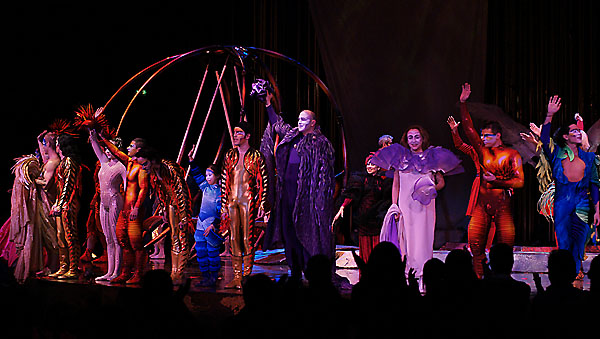
A standing ovation from the dress rehearsal guest audience (50mm at f/2.8). Reviewing the show is not allowed on the basis of dress rehearsal attendance (the hall was packed, mainly with journalists and their families). Since the Premier night the next day had a ticket price of £150 per head, we considered the flights from Scotland and an overnight stay in London well worth while. We also got a very nice full day in the Natural History Museum, an entirely free venue for all the parts we wanted to see, where photography is permitted and even the security guards on the gemstone exhibits do not stop you.
Our thanks to Cirque du Soleil and Brando for making this article possible; it has been my ambition to photograph Cirque du Soleil since first seeing them in Barcelona, and it’s a good thing the Alpha 700 arrived on the scene before I got that chance!
– David Kilpatrick
Please note: all these photographs are © David Kilpatrick and their use is limited, by our agreement signed with the promoters, to Photoworld and Master Photo Digital magazines. Photoclubalpha is the web edition of Photoworld. We are not permitted to offer them for sale or make any other use of them commercially. You may link to the photographs on other website as long as a clear caption also links back to this article, and a byline is given. You may not copy the source file; Cirque du Soleil may take action against any copying of these images.
Cirque du Soleil’s ‘Varekai’ continues at the Royal Albert Hall until February 17th 2008. Tickets are £16-£58 – call the Royal Albert Hall box office on 020 7589 8212 for details, or see their website page for Varekai: http://tickets.royalalberthall.com/season/production.aspx?id=9121&src=t&monthyear=&detect=yes

Before I would to thank for wonderful article. It inspired me to do some low light/high ISO shoots.
I have noticed the same problem with my 50mm f1.4 on A700. Some times A700 did perfect focus, but 80% or even more cases A700+50mm (not with any other Minolta or Sony) produces back focus. Could you find reasonable explanation of that? On my old Minolta 7D with 50mm lens I never have head this problem, actually it was my favorite lens.
No, I didn’t consider the zoom. I knew I would need more than 80mm, so the CZ 16-80mm stayed in the hotel safe. If I had had a 135mm f1.8 I would have taken that (or for that matter an 85mm f1.4), but I don’t have those lenses. I shot RAW+JPEG and processed the raw files with careful comparison against the JPEGs. In some cases the raw could not be processed to produce as good a basic image as the JPEG, in others (the red pole cartwheeling tumblers) strong adjustment improved the impact. In this case, I dropped out a background with plenty of visible stuff and noise. I wanted neither, just plain black for maximum impact.
David
This is simply excellent in every aspect, the writing, the test, the images the colors and the “new” password so I can write you 😉 Was there very much PP after you got home to your computer with the files?
You mention the use of RAW and JPG where you using the RAW+ option or switching between formats as well as the various ISO ranges?
In closing I think I would have taken at least one zoom my very excellent cz1680z because it gets excellent results with only a few stops into the aperture range. So I have to ask if you even consider a zoom?
As Always A Great Piece Of Work David!
Thanks,
Paul
Very good David :-).
This is funny, because my hobby is to take picture of small show in small Bar in Montreal. All the time i have to deal with poor light and small places.
The kit i have created for that is composed of : 28mm F/2.0, 35 F/2.0 and 100 F/2.0. I’m agree with you that you don’t need to bring more that this kind of kit to get most of the scene feeling.
I have use for two times since i have my A700 in show, and i have found too that the ISO6400 keep the good saturation and color. The skin tone of people on the stage can be very good. The only thing i have found is that until ISO3200 with JPEG there is no Gain to shoot more than 6MP.
If i have a guideline to tell to everyone using high ISO with the A700 and they are worry about Card Space (like me 🙂 i have FAST card but not big card). in JPEG with High ISO , don’t use 12mp, it is overkill.
Thank again for this kind of review that make all Sony and Minolta user Proud !
Regards,
Frank
Fantastic! Fantastic! Fantastic! I have known the A700 can deliver the goods at high ISo for sometime now. It is great to see someone do a great gig with the A700 and come up with exceptional results like you did.
I have taken maybe 500 ISO 5000-6400 the past few days and have come to the same conclusions…the Sony A700 delivers great color and good resolution even at ISO6400!
I have been shooting raws lately and doing the IDC thing…but you have tempted me to try the JPG ACR thing!
Great post, great capture, great camera…
Happy shooting!
-Sonolta
http://www.sonolta.com